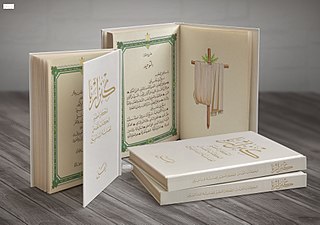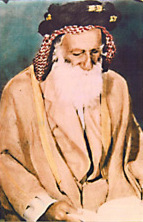Related Research Articles

The Ginza Rabba, Ginza Rba, or Sidra Rabba, and formerly the Codex Nasaraeus, is the longest and the most important holy scripture of Mandaeism.

The Qolastā, Qulasta, Qolusta, or the Canonical Prayerbook is, as the name suggests, a canonical prayer book of the Mandaeans, a Gnostic ethnoreligious group from Iraq and Iran. The Mandaic word qolastā means "collection". The prayerbook is a collection of Mandaic prayers regarding baptisms (masbuta) and other sacred rituals involved in the ascension of the soul (masiqta).
In Mandaeism, Rūha is the queen of the World of Darkness or underworld. She rules the underworld together with her son Ur, the king of the World of Darkness, and her entourage of the seven planets and twelve constellations, who are also her offspring with Ur.
In Mandaeism, the Book of John is a Mandaean holy book in Mandaic Aramaic which Mandaeans attribute to their prophet John the Baptist.
The Book of the Zodiac is a Mandaean text. It covers Mandaean astrology in great detail. The book is used to obtain a Mandaean's baptismal name (malwasha). It is also an important source on Mandaean numerology.
In Mandaeism, ʿUr is the king of the World of Darkness or underworld. He is the son of Ruha, the queen of the underworld, and her brother Gaf, one of the giants in the World of Darkness described in book 5 of the Ginza Rabba. Ur is typically portrayed as a large, ferocious dragon or snake. He is represented by the image of a serpent on the skandola talisman.
The Mandaean Council of Ahvaz is the main organization of the Mandaean religion and the primary authority of the Mandaean ethnic community in Ahvaz, Iran.

Sheikh (Rabbi) Ganzibra Dakhil Aidan was the Iraqi patriarch and international head of the Mandaean religion from 1917, until his death in 1964. The mandi in Liverpool, Sydney, Australia is named in his honor.
In Mandaeism, the World of Darkness is the underworld located below Tibil (Earth). It is ruled by its king Ur (Leviathan) and its queen Ruha, mother of the seven planets and twelve constellations.
In Mandaeism, Shitil is an uthra from the World of Light. Shitil is considered to be the Mandaean equivalent of Seth.
Yahya Bihram was a 19th-century Mandaean priest. Although initially a learned layman (yalufa), he became known for reviving the Mandaean priesthood after a cholera epidemic had killed all living Mandaean priests in 1831. He is mentioned in the colophons of various Mandaean manuscripts.
In Mandaeism, Gaf or Gap is the male consort of Ruha, the queen of the World of Darkness or underworld. His son is Ur, king of the World of Darkness. He is mentioned in book 5 of the Ginza Rabba. Gaf is typically portrayed as a giant.
In Mandaeism, Qin is the mother of Ruha and Zahreil, and grandmother of Ur in the World of Darkness or underworld. In Mandaean texts, she is frequently mentioned as the "queen of darkness." One of her epithets is Sumqaq, which also refers to a well of polluted water in the World of Darkness. Her husband is the demon Anathan.
In Mandaeism, Adathan and Yadathan are a pair of uthras who stand at the Gate of Life in the World of Light, praising and worshipping Hayyi Rabbi. In the Ginza Rabba and Qolasta, they are always mentioned together. Book 14 of the Right Ginza mentions Adathan and Yadathan as the guardians of the "first river".
In Mandaeism, Yawar Ziwa is an uthra from the World of Light. He is the personification of light.
In Mandaeism, a ʿniana or eniana prayer is recited during rituals such as the masiqta and priest initiation ceremonies. There is a total of 26 ʿniana prayers. They form part of the Qolasta.
In Mandaeism, Anush or Anush Uthra is an uthra from the World of Light. Anush is considered to be the Mandaean equivalent of Enos.
Ram Zihrun was a 19th-century Mandaean priest. Although initially a learned layman (yalufa), he became known for reviving the Mandaean priesthood together with his cousin Yahya Bihram after a cholera epidemic had killed all living Mandaean priests in 1831. He is mentioned in the colophons of various Mandaean manuscripts.
Codex Marshall 691 is a Mandaic manuscript currently held at the Bodleian Library, Oxford. It is the oldest Mandaic manuscript that is currently held at a European institutional library and is a prayerbook containing dozens of Mandaean prayers. The contents of the manuscript remain unpublished. Its colophons have been studied in detail by Jorunn Jacobsen Buckley.
References
- 1 2 3 4 Buckley, Jorunn Jacobsen (2010). The great stem of souls: reconstructing Mandaean history. Piscataway, NJ: Gorgias Press. ISBN 978-1-59333-621-9.
- ↑ Buckley, Jorunn Jacobsen (2002). The Mandaeans: ancient texts and modern people. New York: Oxford University Press. ISBN 0-19-515385-5. OCLC 65198443.
